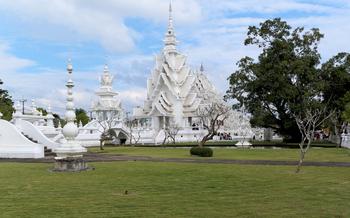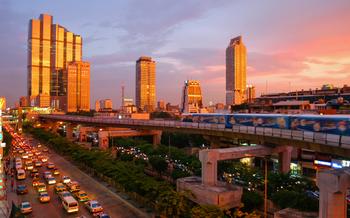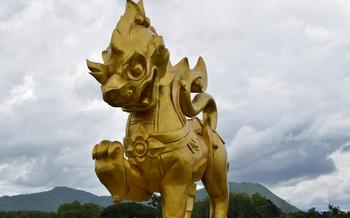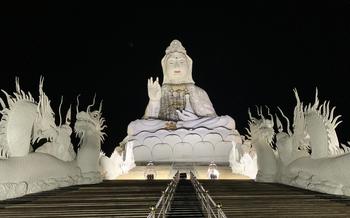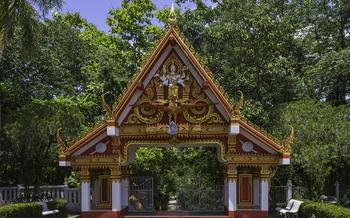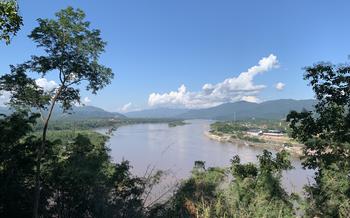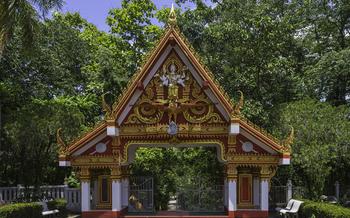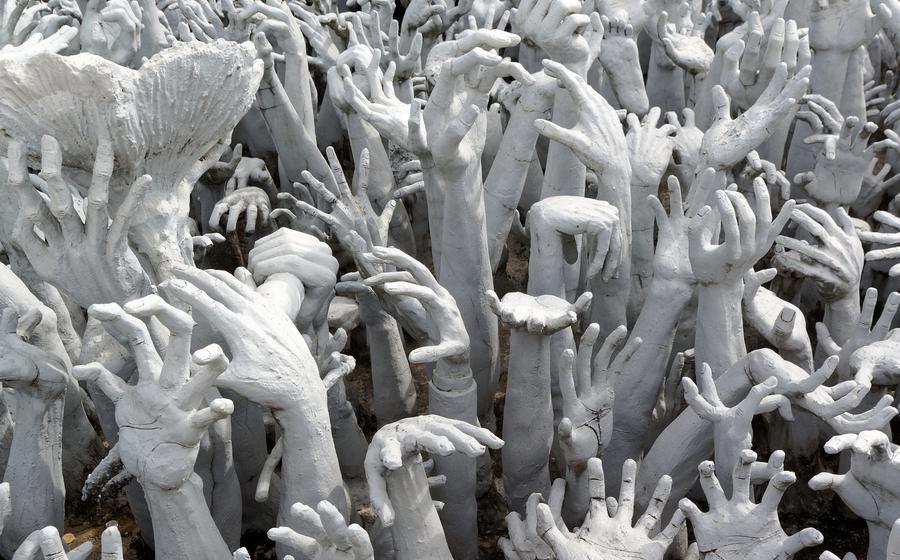
Huay Mak Lium Hot Spring
- Huay Mak Lium Hot Spring: A Serene Haven for Relaxation
- Benefits of Soaking in Hot Springs
- Planning Your Visit to Huay Mak Lium Hot Spring
- Exploring the Surrounding Area
- Accommodation Options Near Huay Mak Lium Hot Spring
- Transportation to Huay Mak Lium Hot Spring
- Tips for a Memorable Hot Spring Experience
- Local Customs and Etiquette
- Safety Precautions
- History of the Huay Mak Lium Hot Spring
- Unique Features of Huay Mak Lium Hot Spring
- Local Cuisine and Delicacies
- Sustainable Tourism Practices
- Insider Tip: Secret Hot Spring Pools
Huay Mak Lium Hot Spring: A Serene Haven for Relaxation
Nestled amidst the lush forests and rolling hills of Chiang Rai, Thailand, lies the enchanting Huay Mak Lium Hot Spring. This natural wonder, with its steaming pools and tranquil ambiance, invites visitors to immerse themselves in a rejuvenating and restorative experience. The hot spring's rich history and cultural significance add to its allure, making it a must-visit destination for those seeking relaxation, wellness, and a profound connection with nature.
Location and Accessibility:
Huay Mak Lium Hot Spring is situated approximately 60 kilometers from Chiang Rai city, offering easy accessibility by car or public transportation. The scenic drive through picturesque countryside and charming villages enhances the journey, providing a glimpse into the region's natural beauty and cultural heritage. Upon arrival, visitors are greeted by the sight of cascading waterfalls and lush greenery, creating a serene and inviting atmosphere that sets the tone for a truly unforgettable experience.
Benefits of Soaking in Hot Springs
The Huay Mak Lium Hot Spring offers a unique and rejuvenating experience that goes beyond relaxation. The mineral-rich waters of the hot springs possess therapeutic properties that provide numerous health benefits.
Soaking in the hot springs helps relieve stress and tension, promoting deep relaxation and tranquility. The warm water soothes muscles, eases aches and pains, and improves blood circulation, leaving you feeling refreshed and revitalized.
The mineral content of the hot spring water also has beneficial effects on skin health. The minerals help cleanse and purify the skin, removing impurities and promoting a healthy glow. The warm water also helps open up pores, allowing the minerals to penetrate deeper into the skin, improving its texture and elasticity.
Overall, a soak in the Huay Mak Lium Hot Spring is not just a relaxing experience but also a therapeutic one, offering a range of health benefits that leave you feeling rejuvenated, refreshed, and revitalized.
Planning Your Visit to Huay Mak Lium Hot Spring
To make the most of your experience at Huay Mak Lium Hot Spring, careful planning is essential. The best time to visit is during the cooler months between November and February when the weather is pleasant and suitable for outdoor activities. Aim to arrive early in the morning to avoid crowds and secure a good spot. Plan to spend at least half a day or even a full day to fully relax and enjoy the various hot spring pools and amenities. Remember to pack essentials like swimwear, towels, and sunscreen to ensure a comfortable and enjoyable experience.
Exploring the Surrounding Area
Beyond the hot spring's serene oasis, a wealth of natural and cultural attractions await exploration. Embark on a scenic hike through the lush forests of Mae Salong National Park, home to diverse flora and fauna. Discover the breathtaking Khun Korn Waterfall, a cascading wonder set amidst picturesque surroundings. Immerse yourself in the rich history and spirituality of the region by visiting ancient temples like Wat Rong Suea Ten, adorned with intricate carvings and colorful murals.
For a taste of local life, venture into the vibrant Mae Sai Market, a bustling hub of trade and cultural exchange. Browse through a myriad of stalls selling fresh produce, handmade crafts, and delicious street food. Interact with friendly locals and soak in the vibrant atmosphere of this vibrant marketplace. Whether you seek adventure, cultural immersion, or simply a chance to connect with nature, the surroundings of Huay Mak Lium Hot Spring offer a diverse range of experiences to enrich your journey.
Accommodation Options Near Huay Mak Lium Hot Spring
When planning a trip to Huay Mak Lium Hot Spring, choosing the right accommodation is crucial. A variety of hotels, resorts, and guesthouses are available near the hot spring, catering to different budgets and preferences.
For a luxurious and pampering experience, opt for one of the upscale resorts in the area. These resorts often offer private hot spring pools, spa treatments, and other amenities for a truly relaxing getaway.
For a more budget-friendly option, consider staying at a guesthouse or a family-run hotel. These accommodations typically provide basic amenities and comfortable rooms at affordable rates.
To ensure a convenient and hassle-free stay, choose an accommodation that is within walking distance or a short drive from the hot spring. This will allow you to easily access the hot spring pools and other facilities without spending too much time on transportation.
When making your booking, inquire about the amenities and facilities offered by the accommodation. Some hotels may provide additional services such as laundry, bicycle rentals, or tour arrangements to enhance your stay.
Whether you prefer luxury or simplicity, choosing the right accommodation near Huay Mak Lium Hot Spring will contribute to a memorable and enjoyable experience.
Transportation to Huay Mak Lium Hot Spring
The Huay Mak Lium Hot Spring is conveniently located approximately 45 kilometers from Chiang Rai city. The journey takes about an hour by car or taxi. If you prefer public transportation, you can take a bus or songthaew from Chiang Rai to Mae Suai district, and then transfer to a local songthaew or motorbike taxi to reach the hot spring. The cost of transportation varies depending on the mode of transport and the distance traveled.
For a more flexible and personalized experience, consider renting a car or hiring a private driver. This allows you to set your own pace and explore the surrounding area at your leisure. However, it's worth noting that renting a car in Thailand requires an International Driving Permit (IDP) and can be more expensive compared to public transportation.
Once you arrive at the hot spring, there is ample parking space available for visitors. Remember to follow local traffic regulations and park your vehicle in designated areas to avoid any inconvenience or fines.
Tips for a Memorable Hot Spring Experience
To make the most of your hot spring experience, here are some tips to consider:
-
Arrive early: Beat the crowds by arriving early in the morning. This will allow you to secure a good spot and enjoy the hot springs in peace and tranquility.
-
Try different pools: Experiment with the different hot spring pools available, as they may vary in temperature and mineral composition. This will give you a unique and diverse hot spring experience.
-
Combine with a massage: For ultimate relaxation, consider combining your hot spring soak with a massage. Many hot spring resorts offer massage services, allowing you to rejuvenate both your body and mind.
Local Customs and Etiquette
When visiting the Huay Mak Lium Hot Spring, it is important to respect Thai customs and traditions to ensure a pleasant and respectful experience. Proper attire is essential, and visitors should avoid wearing revealing or excessively casual clothing in public areas. Additionally, maintaining appropriate behavior is expected, including refraining from loud noises or disruptive actions that may disturb other visitors.
Tipping etiquette is an important aspect of Thai culture. While it is not mandatory, it is customary to leave a small tip for services such as massages or spa treatments. The amount of the tip is at the discretion of the visitor but should be given with a smile and a polite gesture to show appreciation for the service provided.
Safety Precautions
Soaking in hot springs can be a relaxing and enjoyable experience, but it's important to prioritize safety to avoid any potential risks. Here are some precautions to keep in mind:
-
Safe Entry and Exit: Be cautious when entering and exiting the hot spring pools, as the surfaces can be slippery. Use handrails and steps provided to maintain balance and prevent falls.
-
Temperature Awareness: Different pools may have varying temperatures, so test the water before immersing yourself fully. Start with a cooler pool and gradually move to hotter ones to avoid overheating.
-
Hydration: Hot springs can cause dehydration, so it's essential to stay hydrated by drinking plenty of water before, during, and after your soak.
-
Prolonged Exposure: Avoid prolonged exposure to high temperatures, as this can lead to dizziness, nausea, or fainting. Limit your soak to a maximum of 15-20 minutes at a time, and take breaks to cool down.
-
Health Conditions: If you have any underlying health conditions, consult with a doctor before using hot springs, as the heat and mineral content may not be suitable for everyone.
-
Children and Elderly: Ensure that children and elderly individuals are supervised while using the hot springs, as they may be more susceptible to overheating or other risks.
-
Emergency Preparedness: Familiarize yourself with the emergency procedures at the hot spring facility and be aware of the location of first aid stations or staff members in case of any incidents.
History of the Huay Mak Lium Hot Spring
The Huay Mak Lium Hot Spring is steeped in a rich history and cultural significance that dates back centuries. According to local legends and folklore, the hot spring was discovered by a hunter who stumbled upon the site while chasing a wounded animal. Upon immersing himself in the warm waters, he experienced miraculous healing properties that alleviated his ailments. Since then, the hot spring has become a revered site, attracting pilgrims and visitors seeking relief from various health conditions.
Over time, the hot spring gained recognition for its therapeutic benefits and became a popular destination for locals and tourists alike. The surrounding area was developed to accommodate the growing number of visitors, resulting in the construction of bathing facilities, changing rooms, and massage parlors. The hot spring also holds religious significance for many locals, who believe that the waters possess sacred properties and visit the site to pay homage and make offerings.
Unique Features of Huay Mak Lium Hot Spring
The Huay Mak Lium Hot Spring stands out from other hot springs in Thailand due to its distinctive mineral composition and therapeutic properties. The water is rich in various minerals, including sulfur, calcium, and magnesium, which are known for their healing and rejuvenating effects. Soaking in these mineral-rich waters is believed to alleviate various ailments, such as muscle pain, joint stiffness, and skin conditions.
Apart from its therapeutic properties, the Huay Mak Lium Hot Spring is also renowned for its stunning natural surroundings. Nestled amidst lush vegetation and towering trees, the hot spring exudes a serene and tranquil atmosphere. Visitors can immerse themselves in the beauty of nature while enjoying the soothing and revitalizing benefits of the hot spring waters.
Moreover, the Huay Mak Lium Hot Spring holds cultural and religious significance for the local community. According to local folklore, the hot spring possesses mystical powers and is believed to be a sacred site. This belief has led to the development of local traditions and rituals associated with the hot spring, further enriching its cultural and spiritual significance.
Local Cuisine and Delicacies
To complement your rejuvenating hot spring experience, don't miss the opportunity to savor the delectable local cuisine. Within easy reach of Huay Mak Lium Hot Spring, you'll find a variety of restaurants and markets offering an array of culinary delights.
Indulge in authentic Thai dishes that showcase the country's rich culinary heritage. From aromatic curries and refreshing salads to flavorful stir-fries and hearty soups, there's something to satisfy every palate. Be sure to sample the region's signature dishes, such as Khao Soi, a flavorful northern Thai curry noodle soup, and Sai Oua, a grilled sausage made with minced pork, herbs, and spices.
If you're a fan of street food, you're in for a treat. Chiang Rai's vibrant markets and night bazaars offer a tantalizing array of street food stalls serving up everything from Pad Thai and Som Tum (green papaya salad) to grilled meats and sweet treats. Don't be afraid to try new things and embrace the unique flavors and aromas of Thai street food.
When it comes to fruits and snacks, Chiang Rai has plenty to offer. Sample the region's famous lychee, longan, and mangosteen, known for their sweet and juicy flavors. For a refreshing treat, try the local ice cream made with fresh tropical fruits. And don't miss the opportunity to try Khao Neeo Mamuang, a popular sticky rice and mango dessert that's a must-try in Thailand.
By savoring the local cuisine, you'll not only satisfy your taste buds but also gain a deeper appreciation for the rich culinary traditions of northern Thailand. So, be sure to allocate some time to explore the local food scene and indulge in the delicious offerings that await you.
Sustainable Tourism Practices
Huay Mak Lium Hot Spring is committed to preserving the natural beauty and cultural heritage of the area while promoting sustainable tourism practices. Visitors are encouraged to be mindful of their environmental impact and contribute to the conservation efforts. Proper waste disposal facilities are provided, and visitors are advised to minimize their use of single-use plastics. Supporting local businesses and communities is another way to promote sustainable tourism. Visitors can purchase souvenirs and handicrafts from local artisans, dine at locally-owned restaurants, and stay at guesthouses that support the local economy. By embracing sustainable tourism practices, visitors can help ensure the long-term sustainability of Huay Mak Lium Hot Spring and its surrounding environment.
Insider Tip: Secret Hot Spring Pools
Beyond the main hot spring area, adventurous travelers can embark on a journey to discover hidden hot spring pools tucked away in the surrounding nature. These secret pools offer a serene and secluded experience, away from the crowds.
To find these hidden gems, explore the nearby trails and venture into the lush vegetation. Look for small steam vents or natural pools that indicate the presence of hot spring water. Be prepared for a bit of hiking and exploration, as some of these pools are located off the beaten path.
Soaking in these secret hot spring pools is a unique and unforgettable experience. The tranquility and privacy of these hidden spots allow for a deep connection with nature and a truly rejuvenating experience. Remember to respect the environment and leave no trace when exploring these hidden treasures.

